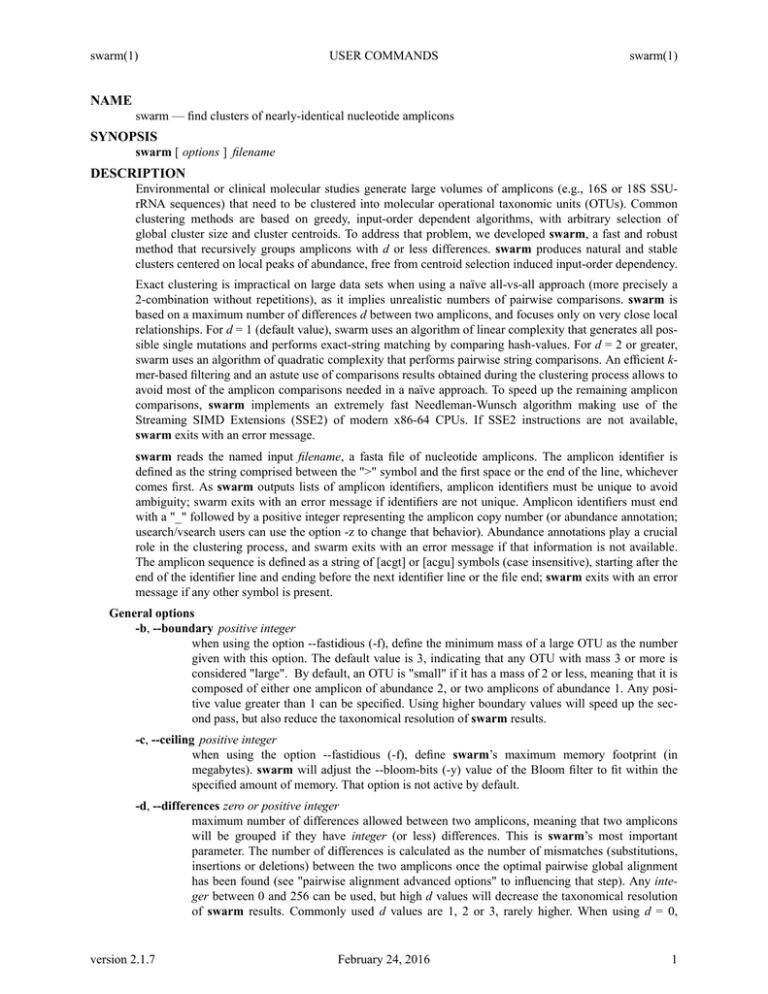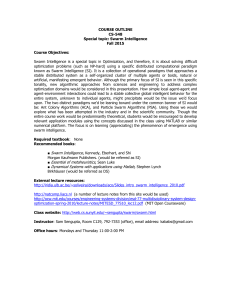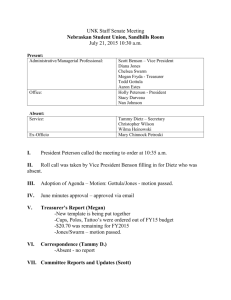NAME SYNOPSIS DESCRIPTION
advertisement

swarm(1) USER COMMANDS swarm(1) NAME swarm — find clusters of nearly-identical nucleotide amplicons SYNOPSIS swarm [ options ] filename DESCRIPTION Environmental or clinical molecular studies generate large volumes of amplicons (e.g., 16S or 18S SSUrRNA sequences) that need to be clustered into molecular operational taxonomic units (OTUs). Common clustering methods are based on greedy, input-order dependent algorithms, with arbitrary selection of global cluster size and cluster centroids. To address that problem, we developed swarm, a fast and robust method that recursively groups amplicons with d or less differences. swarm produces natural and stable clusters centered on local peaks of abundance, free from centroid selection induced input-order dependency. Exact clustering is impractical on large data sets when using a naïve all-vs-all approach (more precisely a 2-combination without repetitions), as it implies unrealistic numbers of pairwise comparisons. swarm is based on a maximum number of differences d between two amplicons, and focuses only on very close local relationships. For d = 1 (default value), swarm uses an algorithm of linear complexity that generates all possible single mutations and performs exact-string matching by comparing hash-values. For d = 2 or greater, swarm uses an algorithm of quadratic complexity that performs pairwise string comparisons. An efficient kmer-based filtering and an astute use of comparisons results obtained during the clustering process allows to avoid most of the amplicon comparisons needed in a naïve approach. To speed up the remaining amplicon comparisons, swarm implements an extremely fast Needleman-Wunsch algorithm making use of the Streaming SIMD Extensions (SSE2) of modern x86-64 CPUs. If SSE2 instructions are not available, swarm exits with an error message. swarm reads the named input filename, a fasta file of nucleotide amplicons. The amplicon identifier is defined as the string comprised between the ">" symbol and the first space or the end of the line, whichever comes first. As swarm outputs lists of amplicon identifiers, amplicon identifiers must be unique to avoid ambiguity; swarm exits with an error message if identifiers are not unique. Amplicon identifiers must end with a "_" followed by a positive integer representing the amplicon copy number (or abundance annotation; usearch/vsearch users can use the option -z to change that behavior). Abundance annotations play a crucial role in the clustering process, and swarm exits with an error message if that information is not available. The amplicon sequence is defined as a string of [acgt] or [acgu] symbols (case insensitive), starting after the end of the identifier line and ending before the next identifier line or the file end; swarm exits with an error message if any other symbol is present. General options -b, --boundary positive integer when using the option --fastidious (-f), define the minimum mass of a large OTU as the number given with this option. The default value is 3, indicating that any OTU with mass 3 or more is considered "large". By default, an OTU is "small" if it has a mass of 2 or less, meaning that it is composed of either one amplicon of abundance 2, or two amplicons of abundance 1. Any positive value greater than 1 can be specified. Using higher boundary values will speed up the second pass, but also reduce the taxonomical resolution of swarm results. -c, --ceiling positive integer when using the option --fastidious (-f), define swarm’s maximum memory footprint (in megabytes). swarm will adjust the --bloom-bits (-y) value of the Bloom filter to fit within the specified amount of memory. That option is not active by default. -d, --differences zero or positive integer maximum number of differences allowed between two amplicons, meaning that two amplicons will be grouped if they have integer (or less) differences. This is swarm’s most important parameter. The number of differences is calculated as the number of mismatches (substitutions, insertions or deletions) between the two amplicons once the optimal pairwise global alignment has been found (see "pairwise alignment advanced options" to influencing that step). Any integer between 0 and 256 can be used, but high d values will decrease the taxonomical resolution of swarm results. Commonly used d values are 1, 2 or 3, rarely higher. When using d = 0, version 2.1.7 February 24, 2016 1 swarm(1) USER COMMANDS swarm(1) swarm will output results corresponding to a strict dereplication of the dataset, i.e. merging identical amplicons. Warning, swarm still requires fasta entries to present abundance values. Default number of differences is 1. -f, --fastidious when working with d = 1, perform a second clustering pass to reduce the number of small OTUs (recommended option). During the clustering process with d = 1, an intermediate amplicon can be missing for purely stochastic reasons, interrupting the aggregation process. That option will create virtual amplicons, allowing to graft small OTUs upon bigger ones. By default, an OTU is "small" if it has a mass of 2 or less (see the --boundary option to increase that value). To speed things up, swarm uses a Bloom filter to store intermediate results. Warning, that second pass can be 2 to 3 times slower than the first pass and requires much more memory. See the options --bloom-bits (-y) or --ceiling (-c) to control the memory footprint of the Bloom filter. Warning, the fastidious option modifies clustering results. The output files produced by the options --log (-l), --output-file (-o), --mothur (-r), --uclust-file, and --seeds (-w) are updated to reflect these modifications; the file --statistics-file (-s) is partially updated (columns 6 and 7 are not updated); the output file --internal-structure (-i) is not updated. -h, --help display this help and exit. -n, --no-otu-breaking deactivate the built-in OTU refinement (not recommended). Amplicon abundance values are used to identify transitions among in-contact OTUs and to separate them, yielding higher-resolution clustering results. That option prevents that separation, and in practice, allows the creation of a link between amplicons A and B, even if the abundance of B is higher than the abundance of A. -t, --threads positive integer number of computation threads to use. The number of threads should be lesser or equal to the number of available CPU cores. Default number of threads is 1. -v, --version output version information and exit. -y, --bloom-bits positive integer when using the option --fastidious (-f), define the size (in bits) of each entry in the Bloom filter. That option allows to balance the efficiency (i.e. speed) and the memory footprint of the Bloom filter. Large values will make the Bloom filter more efficient but will require more memory. Any value between 4 and 20 can be used. Default value is 16. See the --ceiling (-c) option for an alternative way to control the memory footprint. Input/output options -a, --append-abundance positive integer set abundance value to use when some or all amplicons in the input file lack abundance values. Warning, it is not recommended to use swarm on datasets where abundance values are all identical. We provide that option as a courtesy to advanced users, please use it carefully. swarm exits with an error message if abundance values are missing and if this option is not used. -i, --internal-structure filename output all pairs of nearly-identical amplicons to filename using a five-columns tab-delimited format: version 2.1.7 1. amplicon A label. 2. amplicon B label. 3. number of differences between amplicons A and B (positive integer). 4. OTU number (positive integer). OTUs are numbered in their order of delineation, starting from 1. All pairs of amplicons belonging to the same OTU will receive the same number. February 24, 2016 2 swarm(1) USER COMMANDS 5. swarm(1) number of steps from the OTU seed to amplicon B (positive integer). -l, --log filename output all messages to filename instead of standard error, with the exception of error messages of course. That option is useful in situations where writing to standard error is problematic (for example, with certain job schedulers). -o, --output-file filename output clustering results to filename. Results consist of a list of OTUs, one OTU per line. An OTU is a list of amplicon identifiers separated by spaces. Default is to write to standard output. -r, --mothur output clustering results in a format compatible with Mothur. That option modifies swarm’s default output format. -s, --statistics-file filename output statistics to filename. The file is a tab-separated table with one OTU per row and seven columns of information: 1. number of unique amplicons in the OTU, 2. total copy number of amplicons in the OTU, 3. identifier of the initial seed, 4. initial seed copy number, 5. number of amplicons with a copy number of 1 in the OTU, 6. maximum number of iterations before the OTU reached its natural limits), 7. theoretical maximum radius of the OTU (i.e., number of cummulated differences between the seed and the furthermost amplicon in the OTU). The actual maximum radius of the OTU is often much smaller. -u, --uclust-file filename output clustering results in uclust-like file format to the specified file. That option does not modify swarm’s default output format. -w, --seeds filename output OTU representatives to filename in fasta format. The abundance value of each representative is the sum of the abundances of all the amplicons in the OTU. -z, --usearch-abundance accept amplicon abundance values in usearch/vsearch’s style (>label;size=integer[;]). That option influences the abundance annotation style used in output files. Pairwise alignment advanced options when using d > 1, swarm recognizes advanced command-line options modifying the pairwise global alignment scoring parameters: -m, --match-reward positive integer set the reward for a nucleotide match. Default is 5. -p, --mismatch-penalty positive integer set the penalty for a nucleotide mismatch. Default is 4. -g, --gap-opening-penalty positive integer set the gap open penalty. Default is 12. -e, --gap-extension-penalty positive integer set the gap extension penalty. Default is 4. As swarm focuses on close relationships (i.e. d = 2 or 3), clustering results are resilient to pairwise alignment model parameters modifications. Modifying model parameters has a stronger impact when clustering using a higher d value. version 2.1.7 February 24, 2016 3 swarm(1) USER COMMANDS swarm(1) EXAMPLES Clusterize the data set myfile.fasta into OTUs with the finest resolution possible (1 difference, built-in breaking, fastidious option) using 4 computation threads. OTUs are written to the file myfile.swarms, and OTU representatives are written to myfile.representatives.fasta. swarm -t 4 -f -w myfile.representatives.fasta < myfile.fasta > myfile.swarms AUTHORS Concept by Frédéric Mahé, implementation by Torbjørn Rognes. CITATION Mahé F, Rognes T, Quince C, de Vargas C, Dunthorn M. (2014) Swarm: robust and fast clustering method for amplicon-based studies. PeerJ 2:e593 <https://doi.org/10.7717/peerj.593> Mahé F, Rognes T, Quince C, de Vargas C, Dunthorn M. (2015) Swarm v2: highly-scalable and high-resolution amplicon clustering. PeerJ 3:e1420 <https://doi.org/10.7717/peerj.1420> REPORTING BUGS Submit suggestions and bug-reports at <https://github.com/torognes/swarm/issues>, send a pull request on <https://github.com/torognes/swarm>, or compose a friendly or curmudgeonly e-mail to Frédéric Mahé <mahe@rhrk.uni-kl.de> and Torbjørn Rognes <torognes@ifi.uio.no>. AVAILABILITY The software is available from <https://github.com/torognes/swarm> COPYRIGHT Copyright (C) 2012-2016 Frédéric Mahé & Torbjørn Rognes This program is free software: you can redistribute it and/or modify it under the terms of the GNU Affero General Public License as published by the Free Software Foundation, either version 3 of the License, or any later version. This program is distributed in the hope that it will be useful, but WITHOUT ANY WARRANTY; without even the implied warranty of MERCHANTABILITY or FITNESS FOR A PARTICULAR PURPOSE. See the GNU Affero General Public License for more details. You should have received a copy of the GNU Affero General Public License along with this program. If not, see <http://www.gnu.org/licenses/>. SEE ALSO swipe, an extremely fast Smith-Waterman database search tool by Torbjørn Rognes (available from <https://github.com/torognes/swipe>). vsearch, an open-source re-implementation of the classic uclust clustering method (by Robert C. Edgar), along with other amplicon filtering and searching tools. vsearch is implemented by Torbjørn Rognes and documented by Frédéric Mahé, and is available at <https://github.com/torognes/vsearch>. VERSION HISTORY New features and important modifications of swarm (short lived or minor bug releases are not mentioned): v2.1.7 released February 24, 2016 Version 2.1.7 fixes a bug in the output of seeds with the -w option when d > 1 that was not properly fixed in version 2.1.6. It also handles ascii character no 13 (CR) in FASTA files better. Swarm will now exit with status 0 if the -h or the -v option is specified. The help text and some error messages have been improved. v2.1.6 released December 14, 2015 Version 2.1.6 fixes problems with older compilers that do not have the x86intrin.h header file. It also fixes a bug in the output of seeds with the -w option when d > 1. v2.1.5 released September 8, 2015 Version 2.1.5 fixes minor bugs. version 2.1.7 February 24, 2016 4 swarm(1) USER COMMANDS swarm(1) v2.1.4 released September 4, 2015 Version 2.1.4 fixes minor bugs in the swarm algorithm used for d = 1. v2.1.3 released August 28, 2015 Version 2.1.3 adds checks of numeric option arguments. v2.1.1 released March 31, 2015 Version 2.1.1 fixes a bug with the fastidious option that caused it to ignore some connections between large and small OTUs. v2.1.0 released March 24, 2015 Version 2.1.0 marks the first official release of swarm v2. v2.0.7 released March 18, 2015 Version 2.0.7 writes abundance information in usearch style when using options -w (--seeds) in combination with -z (--usearch-abundance). v2.0.6 released March 13, 2015 Version 2.0.6 fixes a minor bug. v2.0.5 released March 13, 2015 Version 2.0.5 improves the implementation of the fastidious option and adds options to control memory usage of the Bloom filter (-y and -c). In addition, an option (-w) allows to output OTU representatives sequences with updated abundances (sum of all abundances inside each OTU). This version also enables swarm to run with d = 0. v2.0.4 released March 6, 2015 Version 2.0.4 includes a fully parallelised implementation of the fastidious option. v2.0.3 released March 4, 2015 Version 2.0.3 includes a working implementation of the fastidious option, but only the initial clustering is parallelized. v2.0.2 released February 26, 2015 Version 2.0.2 fixes SSSE3 problems. v2.0.1 released February 26, 2015 Version 2.0.1 is a development version that contains a partial implementation of the fastidious option, but it is not usable yet. v2.0.0 released December 3, 2014 Version 2.0.0 is faster and easier to use, providing new output options (--internal-structure and --log), new control options (--boundary, --fastidious, --no-otu-breaking), and built-in OTU refinement (no need to use the python script anymore). When using default parameters, a novel and considerably faster algorithmic approach is used, guaranteeing swarm’s scalability. v1.2.21 released February 26, 2015 Version 1.2.21 is supposed to fix some problems related to the use of the SSSE3 CPU instructions which are not always available. v1.2.20 released November 6, 2014 Version 1.2.20 presents a production-ready version of the alternative algorithm (option -a), with optional built-in OTU breaking (option -n). That alternative algorithmic approach (usable only with d = 1) is considerably faster than currently used clustering algorithms, and can deal with datasets of 100 million unique amplicons or more in a few hours. Of course, results are rigourously identical to the results previously produced with swarm. That release also introduces new options to control swarm output (options -i and -l). v1.2.19 released October 3, 2014 Version 1.2.19 fixes a problem related to abundance information when the sequence identifier includes multiple underscore characters. version 2.1.7 February 24, 2016 5 swarm(1) USER COMMANDS swarm(1) v1.2.18 released September 29, 2014 Version 1.2.18 reenables the possibility of reading sequences from stdin if no file name is specified on the command line. It also fixes a bug related to CPU features detection. v1.2.17 released September 28, 2014 Version 1.2.17 fixes a memory allocation bug introduced in version 1.2.15. v1.2.16 released September 27, 2014 Version 1.2.16 fixes a bug in the abundance sort introduced in version 1.2.15. v1.2.15 released September 27, 2014 Version 1.2.15 sorts the input sequences in order of decreasing abundance unless they are detected to be sorted already. When using the alternative algorithm for d = 1 it also sorts all subseeds in order of decreasing abundance. v1.2.14 released September 27, 2014 Version 1.2.14 fixes a bug in the output with the --swarm_breaker option (-b) when using the alternative algorithm (-a). v1.2.12 released August 18, 2014 Version 1.2.12 introduces an option --alternative-algorithm to use an extremely fast, experimental clustering algorithm for the special case d = 1. Multithreading scalability of the default algorithm has been noticeably improved. v1.2.10 released August 8, 2014 Version 1.2.10 allows amplicon abundances to be specified using the usearch style in the sequence header (e.g. ">id;size=1") when the -z option is chosen. v1.2.8 released August 5, 2014 Version 1.2.8 fixes an error with the gap extension penalty. Previous versions used a gap penalty twice as large as intended. That bug correction induces small changes in clustering results. v1.2.6 released May 23, 2014 Version 1.2.6 introduces an option --mothur to output clustering results in a format compatible with the microbial ecology community analysis software suite Mothur (<http://www.mothur.org/>). v1.2.5 released April 11, 2014 Version 1.2.5 removes the need for a POPCNT hardware instruction to be present. swarm now automatically checks whether POPCNT is available and uses a slightly slower software implementation if not. Only basic SSE2 instructions are now required to run swarm. v1.2.4 released January 30, 2014 Version 1.2.4 introduces an option --break-swarms to output all pairs of amplicons with d differences to standard error. That option is used by the companion script ‘swarm_breaker.py‘ to refine swarm results. The syntax of the inline assembly code is changed for compatibility with more compilers. v1.2 released May 16, 2013 Version 1.2 greatly improves speed by using alignment-free comparisons of amplicons based on k-mer word content. For each amplicon, the presence-absence of all possible 5-mers is computed and recorded in a 1024-bits vector. Vector comparisons are extremely fast and drastically reduce the number of costly pairwise alignments performed by swarm. While remaining exact, swarm 1.2 can be more than 100-times faster than swarm 1.1, when using a single thread with a large set of sequences. The minor version 1.1.1, published just before, adds compatibility with Apple computers, and corrects an issue in the pairwise global alignment step that could lead to sub-optimal alignments. version 2.1.7 February 24, 2016 6 swarm(1) USER COMMANDS swarm(1) v1.1 released February 26, 2013 Version 1.1 introduces two new important options: the possibility to output clustering results using the uclust output format, and the possibility to output detailed statistics on each OTU. swarm 1.1 is also faster: new filterings based on pairwise amplicon sequence lengths and composition comparisons reduce the number of pairwise alignments needed and speed up the clustering. v1.0 released November 10, 2012 First public release. version 2.1.7 February 24, 2016 7








